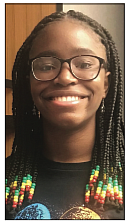How I found my voice as a Black student, by Etana Williams
12/22/2022, 6 p.m.
I was excitedly talking with my friends about our high school plans when one of my eighth-grade teachers stopped me in the hallway and asked which school I got into.
“Brooklyn Tech,” I said with a smile, thinking of the months I spent studying for the specialized high school exam, or SHSAT.
“Oh, good,” she said. “You know they only accepted seven Black students at Stuyvesant this year? It’s sad.”
I wasn’t sure what to say. I knew that specialized New York City high schools like Stuyvesant and Brooklyn Tech enrolled a small percentage of Black students. In 2019, the year I was accepted, merely 5.7 percent of students at Tech were Black; that’s 341 Black students out of a total enrollment of 5,940. When I was first admitted, those demographics didn’t bother me.
But that fall, after the first-day excitement wore off, I began noticing certain patterns. Like how I was one of, at most, three Black faces in my classes. And how none of my teachers looked like me.
Regularly hearing slurs coming from the mouths of my peers and snickering at racially charged jokes that shouldn’t have been made — it agitated me.
I didn’t stand up for myself, and I didn’t have a space to share my feelings of isolation and powerlessness. In previous years, I didn’t mind the lack of diversity in my friend groups. Now it bothered me that I only had one Black friend at the start of my freshman year.
Then at a club fair a few weeks into the school year, I saw a table where a group of Black students was socializing. I made eye contact with one of the girls there. She smiled as she approached me and asked if I would like to put my email down to join Brooklyn Tech’s Black Student Union. Before then, I had no idea that this club existed. I enthusiastically agreed.
The following Monday, I walked into my first Black Student Union meeting. I remember seeing a sea of Black faces and wondering how there could be so many of us here when I barely saw enough on a daily basis to count on one hand. I took a seat and looked around, excitedly.
“We know how small the Black population is here at Tech, so we wanted to have a space where we could all come together,” said one of the group’s leaders. “We want to create a family.”
Mondays at the Black Student Union became an anchor of my time at Tech. It was where I could have in-depth, honest conversations with peers. We processed George Floyd’s death and Kyle Rittenhouse’s acquittal. We talked about our experiences in and out of school, and shared our sadness, pain, anger and also joy.
Junior year, I tried out for (and made) the Step Team. It was a majority Black space; and I soon realized that the Black Student Union wasn’t the only place I could feel comfortable and accepted.
I was spending most days after school in spaces surrounded by people who looked like me. I got to know the Black students I had seen in the hallways and in my classes. The microaggressions and uncomfortable stares didn’t stop, but the way I approached them did. Rather than staying quiet, I responded:
“Why do you think that’s OK for you to say?”
“That’s not funny.”
“Your words have an impact, you should choose them more wisely.”
Pointing out ignorance still wasn’t easy, but I knew I had a network of Black friends and Black teachers that I met through my clubs to confide in. Letting these comments slide was a form of compliance that I was no longer willing to accept.
It shouldn’t have been so difficult to feel welcomed in my own school. Something is wrong when students feel alienated in the space where they spend the majority of their time. My experience is part of a bigger problem. Black students remain vastly underrepresented at New York’s elite specialized high schools.
This doesn’t mean that Black students should avoid applying to these schools. Just the opposite. Simply enrolling as a student of color creates more inclusive spaces for future students. While it hasn’t been easy being one of a few Black students at my school, finding accepting communities has made the experience worthwhile.
Etana Williams, 17, is a senior at Brooklyn Technical High School. Her essay is courtesy of Chalkbeat New York.








